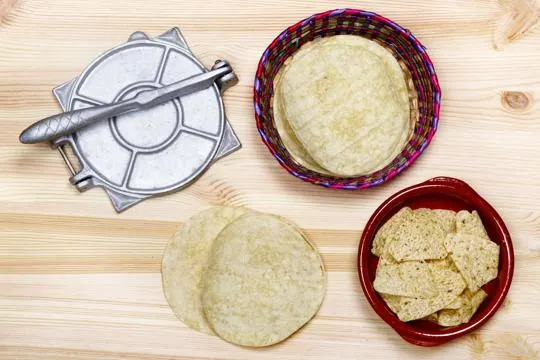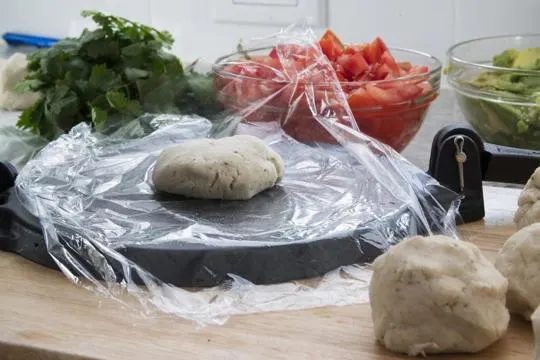Summary of key points
The main difference between a wood and cast iron tortilla press lies in their durability and weight. Wood presses are typically lighter and more affordable, but they may not be as sturdy or long-lasting as cast iron presses. Cast iron presses, on the other hand, are heavier and more expensive, but they can withstand heavy use and may produce perfectly round tortillas more easily.
In terms of function, both types of presses work similarly – they flatten balls of dough into thin, round tortillas. Some people prefer the traditional look and feel of a wood press, while others appreciate the sturdiness and even heat distribution of cast iron. In terms of maintenance, wood presses may need to be oiled occasionally to prevent cracking, while cast iron presses should be seasoned regularly to prevent rusting.
Tortilla presses. You’ve seen them. Maybe in a store, or in a kitchen, or even online.
Two types stand out: wood and cast iron. Each has its fans. We’re here to break down the differences. Ever tried making tortillas at home? We did. And guess what? The press makes all the difference.
Wood presses have a charm. They’re lightweight and look great on a countertop. Cast iron? Heavy-duty. They mean business and last forever.
We’ve battled with both. Our kitchens have seen the drama unfold. Want the inside scoop? Stick around.
What is a Tortilla Press?

A tortilla press is a kitchen tool used for flattening dough to make flatbreads called tortillas.
It evenly presses the dough creating thin discs.
This traditional Mexican device is better than rolling out each tortilla by hand.
When it comes to choosing, there are two main options: wood and cast iron.
Wood presses offer a rustic charm and are handmade.
They are lighter and easier to handle – making them a popular choice for home cooks.
Cast iron presses are known for durability and heavy weight – they press the dough more evenly.
Wooden tortilla presses usually have smooth surfaces that don’t stick, but cast iron presses need seasoning or extra steps to prevent sticking.
For maintenance, wooden presses need oiling to maintain their finish, while cast iron presses need cleaning and seasoning.
Types of Tortilla Presses
Tortilla presses exist in different styles.
Wood and cast iron are the two most popular.
Wood presses ooze traditional vibes and are lightweight.
Cast iron ones are long-lasting and spread heat well.
It’s all about personal choice and use.
If you like classic style, go for a wooden press.
For reliability, take the cast iron one.
Regardless, a tortilla press is a must-have for making homemade tortillas with ease and authenticity.
1 – Wood Tortilla Press
Wood tortilla presses are a classic tool for homemade tortillas.
The use of wood adds a rustic charm, making it feel like an authentic culinary experience.
These presses are usually handcrafted and skillfully designed, allowing for simple dough flattening.
The natural texture of the wood adds a unique touch to the tortillas.
Wood tortilla presses have the advantage of absorbing excess moisture from the dough.
This helps get the perfect texture and consistency.
Plus, the wooden surface gives gentle pressure to prevent dough from sticking or tearing.
Wood tortilla presses also have an aesthetic appeal.
They can be made from hardwoods like oak, maple, or pine.
Some feature intricate carvings or designs on their handles and surfaces, making them beautiful decorative pieces when not in use.
However, wood tortilla presses require extra care compared to cast iron ones.
Wood is more susceptible to moisture damage and may need periodic conditioning or oiling.
It is also best to clean these presses by wiping them with a damp cloth, rather than immersing them in water.
2 – Cast Iron Tortilla Press
The cast iron tortilla press is a go-to for chefs and home cooks.
It’s built to last and its weight helps spread the pressure evenly when pressing.
This makes perfectly round, thin tortillas each time.
A cast iron press is great at retaining heat.
The material absorbs heat, so the dough cooks quickly and evenly.
Especially helpful when making big batches of tortillas, as it keeps the same temperature.
Plus, cast iron allows for precise control over thickness.
Just change the pressure and you can make each tortilla as thin or thick as you like.
Perfect for those wanting delicate tortillas or thicker ones that hold fillings.
Also, the weight of the cast iron press means it’s easier to handle.
It does most of the work, saving time and effort.
A great tool for those making homemade tortillas.
In conclusion, the cast iron tortilla press offers durability, heat retention, control over thickness, and effortless handling.
Making it an ideal choice for anyone looking for restaurant-level results at home.
So if you’re a pro or a beginner, get a cast iron press for all your tortilla needs.
Comparison of Wood Tortilla Press and Cast Iron Tortilla Press

Wood and cast iron tortilla presses are two common types of tools used for making homemade tortillas.
But, they have distinct features and benefits.
The main difference is in the material used to make them.
Wood presses are made of tough hardwood, such as pine or oak.
This gives them a traditional look.
On the other hand, cast iron presses are crafted from strong iron.
Also, wood presses are usually lighter and smaller than cast iron ones.
This makes them easier to manage and store, perfect for those with limited kitchen space.
In terms of performance, both presses can flatten dough balls into circles.
But, some say that cast iron gives a better press.
Maintenance is key too.
Wood presses must be cleaned by hand with mild detergent and dried with a towel.
Cast iron presses need seasoning and should only be cleaned with hot water.
No soap. Finally, cost is something to consider.
Wood presses are usually more budget-friendly compared to cast iron ones.
1 – Material and Construction
Material and construction are key when selecting a tortilla press.
Wood is often favored for its classic look and natural vibe.
Plus, it gives a gentler contact, aiding in more control during the pressing.
Cast iron, however, is sturdier and longer-lasting.
It’s weighty, aiding to give an even pressure for even thickness in tortillas.
Both materials have their benefits.
The choice depends upon individual preference and needs.
2 – Durability and Maintenance
Durability and maintenance are key points to ponder when choosing between a wood or cast iron tortilla press.
Wood presses boast natural beauty and refined craftsmanship, but may need more attention.
Cast iron presses offer sturdiness and durability, with less upkeep.
Wood tortilla presses possess a special charm that adds elegance to any kitchen.
Meticulously crafted, their beauty radiates from the wood grains.
To ensure the press’s longevity, avoid direct heat sources, as too much heat can cause warping or cracking.
Plus, oil it regularly with food-grade mineral oil to keep it smooth and prevent drying out.
Cast iron presses are well-known for their durability.
Built for heavy use, they can handle thick dough with ease.
Their weighty nature provides stability during pressing for consistent results.
To maintain them, just wipe clean with a damp cloth and dry after each use to avoid rusting.
At the end of the day, it comes down to personal preference and individual needs.
If you love woodworking and don’t mind the extra upkeep, a wood press may be right for you.
If you value durability and low maintenance, go for the cast iron option.
3 – Weight and Stability
Weight and stability are two factors to take into account when selecting a wood or cast iron tortilla press.
Weight influences the stability of the press while using it, and a heavier press offers more stability, so it won’t move on the countertop.
Heavier presses require more effort to use, but they provide uniform pressure for consistent results.
On the flip side, a lighter press is easier to handle, but it may not press the tortillas evenly.
Cast iron presses are usually heavier than their wooden counterparts.
Cast iron is dense and offers great stability, as well as even distribution of pressure, for perfectly pressed tortillas.
Wooden presses, on the other hand, can be made of high-quality hardwood like oak or pine, yielding sufficient stability.
They also have a rustic charm and look great in the kitchen.
Moreover, wooden presses are known to absorb moisture from the dough, preventing it from sticking during pressing, which is beneficial when working with sticky masa dough.
In conclusion, wood and cast iron tortilla presses have their own benefits regarding weight and stability.
It’s all about personal preference and individual needs when deciding which type of press is best for you.
Whether you choose a heavy-duty cast iron press or opt for a lighter wooden one, both will help you make delicious homemade tortillas.
4 – Heat Distribution and Cooking Results
When it comes to heat distribution and cooking results, wood and cast iron tortilla presses differ greatly.
Wood presses absorb and release heat more evenly, resulting in perfectly cooked tortillas.
Cast iron presses may provide slightly uneven heat but excel in retaining it.
This allows for crispy and well-browned tortillas with a rustic and slightly charred flavor.
The choice of which press to use is up to personal preference.
Soft or crispy tortillas? Experiment with both to find your preferred cooking style.
Enjoy the art of making homemade tortillas to perfection.
Considerations When Choosing Between Wood and Cast Iron Tortilla Press

When deciding between a wood or cast iron tortilla press, there are some points to bear in mind.
Wood presses have a classic look and feel.
Cast iron ones offer durability and even heat distribution.
Both have pros and cons, so it’s up to your preference.
Maintenance is one factor.
Wood needs to be oiled before use and re-oiled from time to time.
Cast iron only needs one seasoning and can last for years with little care.
Weight is another point.
Wood is lighter, so it’s easier to use and move.
Cast iron is heavier, but gives more stability and pressure when pressing.
Heat retention is a crucial factor.
Cast iron holds heat better, making evenly cooked tortillas.
Wood gives a slower cooking process and a more traditional texture.
Lastly, cost.
Wood is usually cheaper, however, a high-quality cast iron press can be worth the investment due to its durability and high heat tolerance.
Where to Buy Wood and Cast Iron Tortilla Presses?
If you need one, there are five places to check out.
- Kitchenware stores often carry a variety of presses. Check out local stores or chains.
- Online marketplaces like Amazon, eBay, and Walmart are great for browsing and comparing.
- Specialty Mexican grocery stores usually have traditional wood presses.
- Farmers’ markets sometimes have handmade tortilla presses.
- Estate sales or garage sales could have vintage or used items.
Plus, some online retailers offer customization options for the perfect press.
Conclusion
Overall, both wood and cast iron tortilla presses have their own advantages and drawbacks.
Wood tortilla presses can be used to perfectly flatten dough made of different ingredients while cast iron is better for temperatures.
Each type brings something unique to the table.
However, when it comes to the quality of the final product, users may have a preferred choice based on repeatability and durability.
In the end, it’s up to the consumer to decide which one is the perfect choice for them.
No matter which press you choose, you will be able to enjoy freshly made tortillas with ease.
So roll up those sleeves and get ready for some tasty homemade Mexican cuisine.

Leave a comment